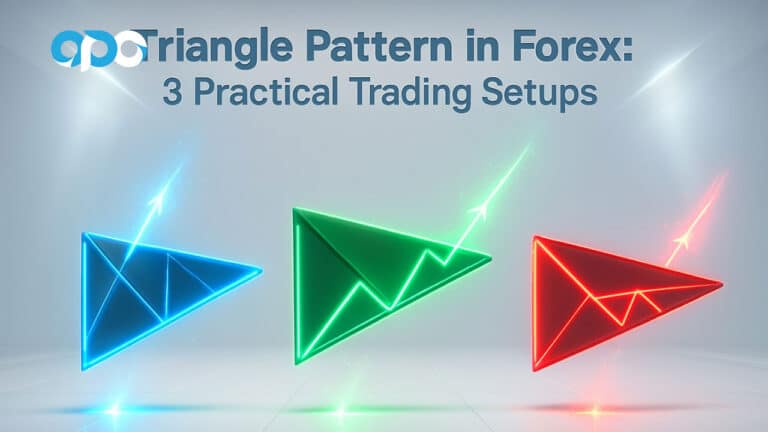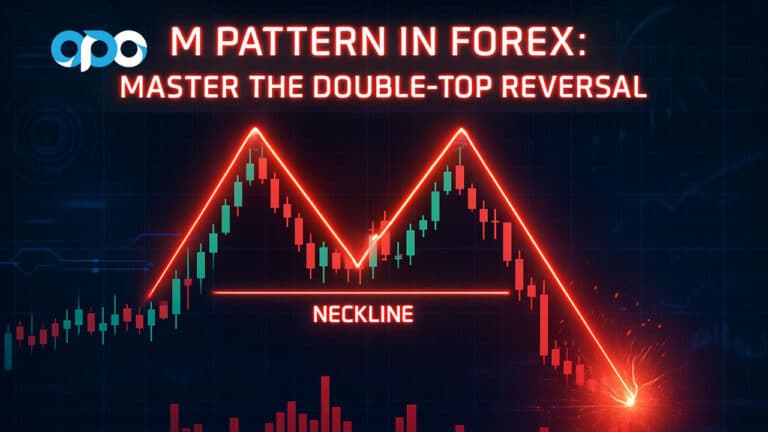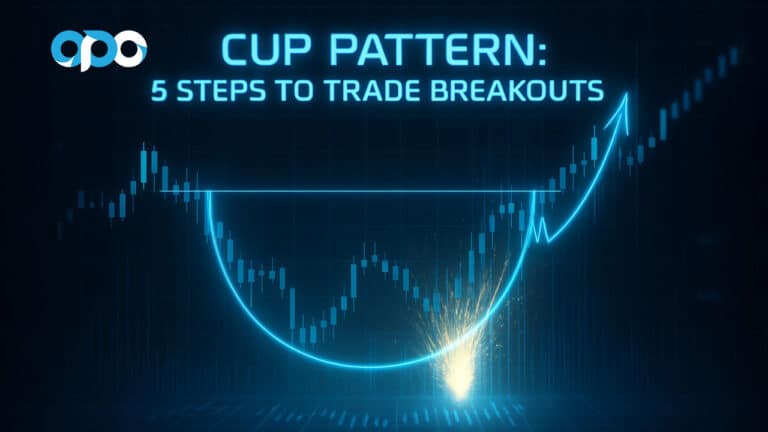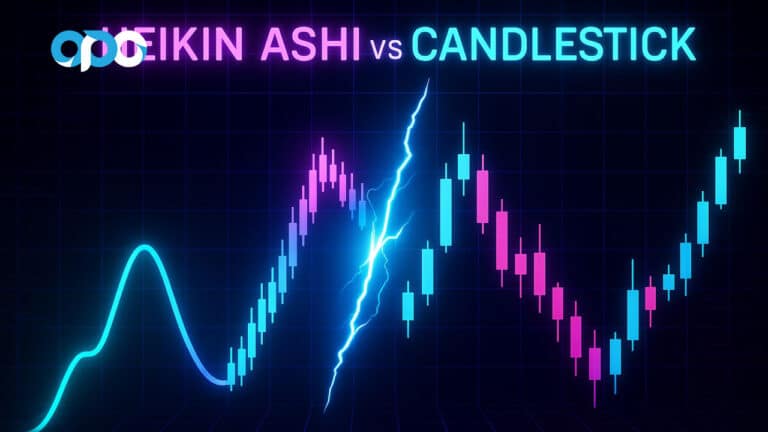Imagine stepping into the Forex market with a strategy that consistently deciphers market movements, enabling you to make informed and profitable trades. In the highly competitive and ever-evolving landscape of financial trading, selecting the right strategy is paramount. Two prominent methodologies often debated among traders are Price Action and ICT (Inner Circle Trader). Each offers unique approaches and benefits, but which one truly stands out?
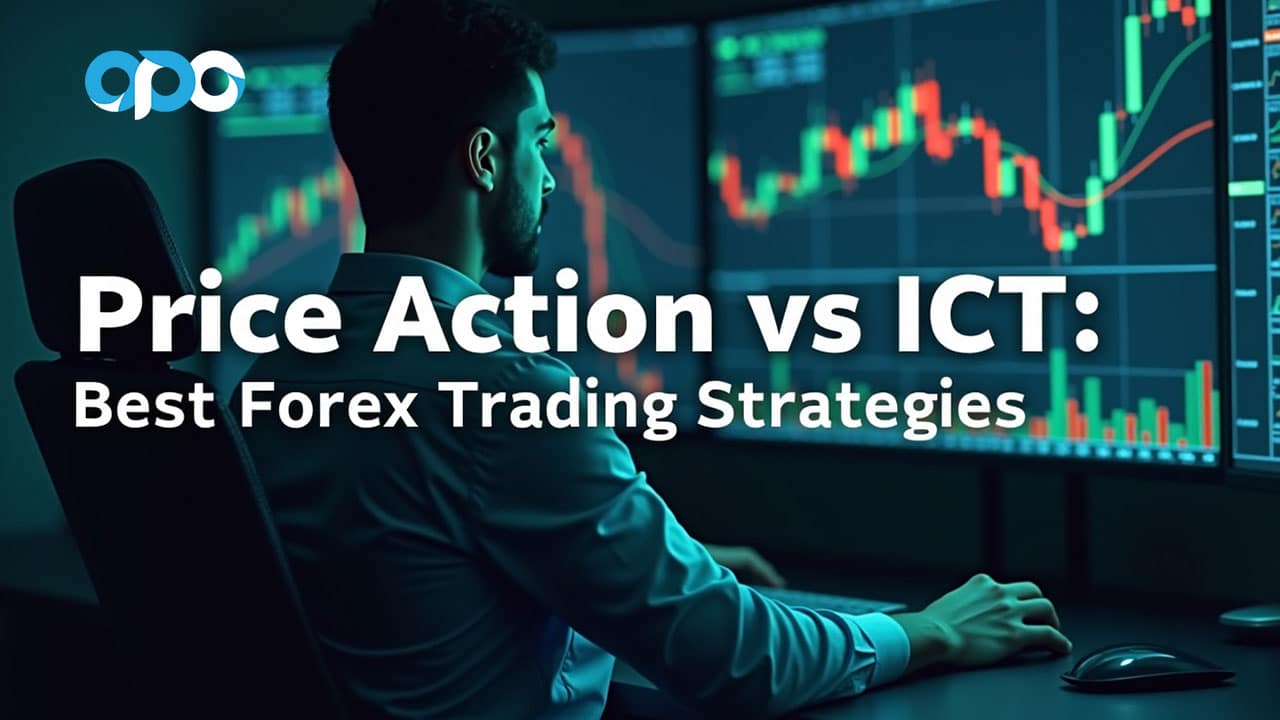
This comprehensive guide delves deep into Price Action vs ICT, providing you with a clear understanding of both strategies to help you determine which aligns best with your trading goals. Whether you’re seeking insights from a reliable online forex broker or aiming to enhance your trading techniques, this article is designed to equip you with the knowledge needed to navigate the complexities of the Forex market effectively.
Explore the core principles, advantages, and real-world applications of each strategy, and uncover the secrets to achieving consistent trading success.
Understanding Price Action Trading
Price Action trading has gained immense popularity due to its simplicity and effectiveness. It focuses solely on the price movements of an asset, disregarding complex indicators or algorithms. This approach allows traders to interpret raw price data and predict future market movements with greater accuracy.

What is Price Action Trading?
Price Action trading is a methodology that relies exclusively on the historical price movements of an asset to make trading decisions. Instead of depending on lagging indicators, Price Action traders analyze patterns, trends, and key price levels to anticipate future price movements. This method is versatile and can be applied across various timeframes and markets, making it a favorite among both novice and experienced traders.
By focusing on the fundamental movements of price, traders can gain a clearer and more direct insight into market behavior.
Read More: price action vs Elliott wave
Core Principles of Price Action
To effectively utilize Price Action trading, it’s essential to understand its core principles:
Market Structure Analysis: This involves identifying the overall trend, whether it’s bullish, bearish, or ranging. Understanding the market structure helps in determining the direction of future price movements.
Candlestick Patterns: Specific candlestick formations, such as pin bars, engulfing patterns, and dojis, provide valuable signals about potential market reversals or continuations. These patterns help traders gauge market sentiment and make informed decisions.
Support and Resistance Levels: Recognizing key price levels where the market tends to reverse or consolidate is crucial. Support levels indicate where buying interest is strong enough to prevent the price from falling further, while resistance levels highlight areas where selling pressure may overcome buying interest.
Advantages of Price Action Trading
Price Action trading offers several benefits that make it a preferred choice for many traders:
- Simplicity: The approach is straightforward and easy to understand, eliminating the need for complex indicators or tools.
- Flexibility: Applicable across different timeframes and market conditions, Price Action can be adapted to suit various trading styles.
- Clarity: By focusing solely on price movements, traders can avoid the noise and distractions caused by multiple indicators, leading to clearer decision-making.
Disadvantages of Price Action Trading
Despite its advantages, Price Action trading has its limitations:
- Subjectivity: The interpretation of price patterns can vary between traders, leading to inconsistent results.
- Requires Experience: Mastery of Price Action requires significant time and practice, which can be challenging for beginners.
- Limited Tools: Reliance on price data alone may limit the trader’s ability to incorporate additional analytical tools that could enhance decision-making.
While Price Action trading is accessible and versatile, it demands a keen eye and disciplined approach to achieve consistent success.
Understanding ICT (Inner Circle Trader) Trading
The ICT (Inner Circle Trader) methodology, developed by Michael J. Huddleston, offers a more intricate and in-depth approach to Forex trading. It delves into the hidden mechanics of the financial markets, providing traders with advanced tools and concepts to gain a strategic edge. ICT trading is designed for those who seek a deeper understanding of market dynamics beyond surface-level price movements.
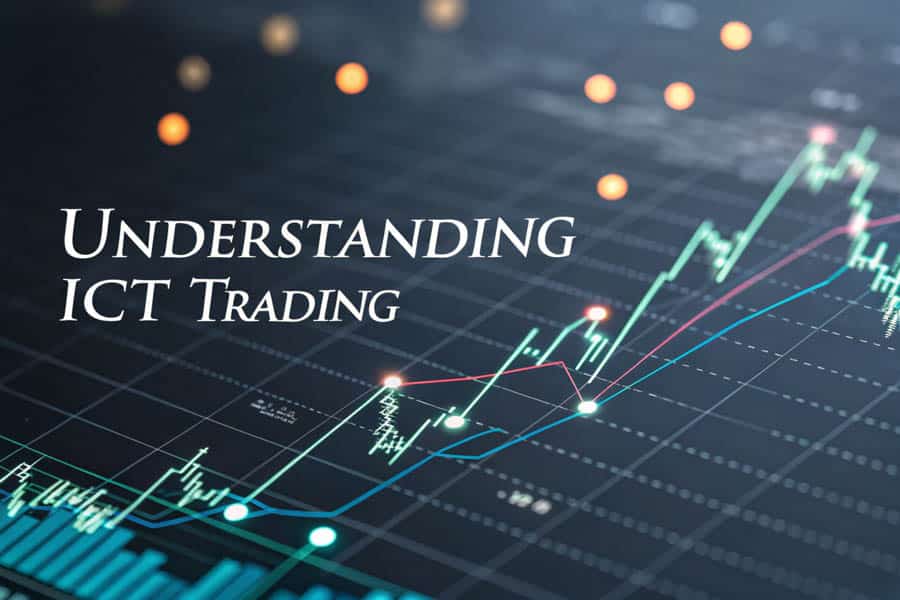
What is ICT Trading?
ICT trading is a comprehensive trading methodology that emphasizes understanding the underlying market dynamics manipulated by institutional players. Unlike traditional trading strategies that focus primarily on price movements, ICT incorporates elements like liquidity pools, order blocks, and market manipulation awareness to provide a deeper insight into market behavior. This methodology aims to uncover the hidden forces driving the markets, enabling traders to anticipate and react to large institutional movements that can significantly impact price action.
ICT trading equips traders with advanced knowledge to anticipate market moves influenced by large financial institutions, offering a strategic advantage in the Forex market.
Core Principles of ICT Trading
ICT trading is built upon several advanced concepts that distinguish it from other trading methodologies. These principles provide traders with a framework to understand and navigate the complexities of the Forex market.
- Liquidity Pools: These are areas where large orders accumulate, significantly impacting price movements. Identifying liquidity pools helps traders anticipate where major price shifts might occur, as institutions often place large orders around these zones to manipulate the market direction.
- Order Blocks: Recognizing significant price levels where institutional traders place their orders is crucial. Order blocks indicate areas of high supply or demand, providing potential entry and exit points. By understanding where these blocks are located, traders can better predict future price movements and market reactions.
- Market Manipulation Awareness: Understanding how large players can influence the market to their advantage allows traders to anticipate and react to market movements more effectively. ICT trading teaches traders to recognize signs of manipulation, such as false breakouts or liquidity sweeps, which can help in avoiding unfavorable trades.
- Smart Money Concepts: ICT focuses on the actions of “smart money” or institutional traders. By analyzing their behavior and strategies, traders can align their trades with the movements of these large players, increasing the likelihood of successful trades.
- Time of Day Analysis: Recognizing the importance of market sessions and the impact of different trading hours on liquidity and volatility is a key aspect of ICT trading. Understanding when major institutions are active can help traders time their entries and exits more effectively.
- Fibonacci and Harmonic Patterns: ICT incorporates advanced technical tools such as Fibonacci retracements and harmonic patterns to identify potential reversal and continuation points in the market. These tools enhance the precision of trade entries and exits.
Read More: Price Action in Forex Trading
Advantages of ICT Trading
ICT trading offers distinct benefits that cater to more experienced traders seeking a strategic edge. These advantages stem from the methodology’s depth and comprehensive approach to market analysis.
- Depth of Analysis: ICT provides a comprehensive understanding of market mechanics beyond basic price movements. By delving into the actions of institutional players and market manipulation tactics, traders gain a deeper insight into the forces driving the market.
- Strategic Edge: Equipping traders with tools to anticipate market moves influenced by institutional players offers a competitive advantage. This strategic edge allows traders to position themselves ahead of major market shifts, enhancing their potential for profitable trades.
- Enhanced Risk Management: ICT trading incorporates advanced techniques to manage and mitigate risks effectively. Understanding liquidity pools and order blocks enables traders to set more precise stop-loss and take-profit levels, improving overall risk-reward ratios.
- Increased Trade Accuracy: By aligning trades with the movements of smart money, ICT traders can achieve higher accuracy in their trades. This alignment reduces the likelihood of false signals and increases the probability of successful trades.
- Comprehensive Market Understanding: ICT trading fosters a holistic understanding of the Forex market, enabling traders to make informed decisions based on a wide range of market factors and indicators.
Disadvantages of ICT Trading
Despite its advantages, ICT trading also comes with its challenges. These drawbacks are important to consider when deciding whether this methodology aligns with your trading style and objectives.
- Complexity: The methodology is more complex compared to simpler strategies like Price Action. Mastering ICT requires a deep understanding of advanced concepts, which can be daunting for many traders.
- Time-Consuming: Mastering ICT concepts demands significant time investment. Traders need to dedicate hours to study and practice to fully grasp the intricacies of the methodology, which may not be feasible for those with limited time.
- Overwhelming for Beginners: The depth and complexity of ICT can be intimidating for those new to trading. Without a solid foundation in basic trading principles, beginners might struggle to comprehend and apply ICT concepts effectively.
- Higher Learning Curve: The steep learning curve associated with ICT trading can lead to frustration and inconsistency, especially for traders who are not committed to continuous learning and practice.
- Potential for Overcomplication: Given the advanced nature of ICT, there’s a risk of overcomplicating the trading process. Traders may find themselves relying too heavily on multiple indicators and concepts, which can obscure clear trading signals.
Comparative Analysis: Price Action vs ICT
When deciding between Price Action vs ICT, it’s essential to understand the similarities and differences to determine which strategy best suits your trading style and goals.
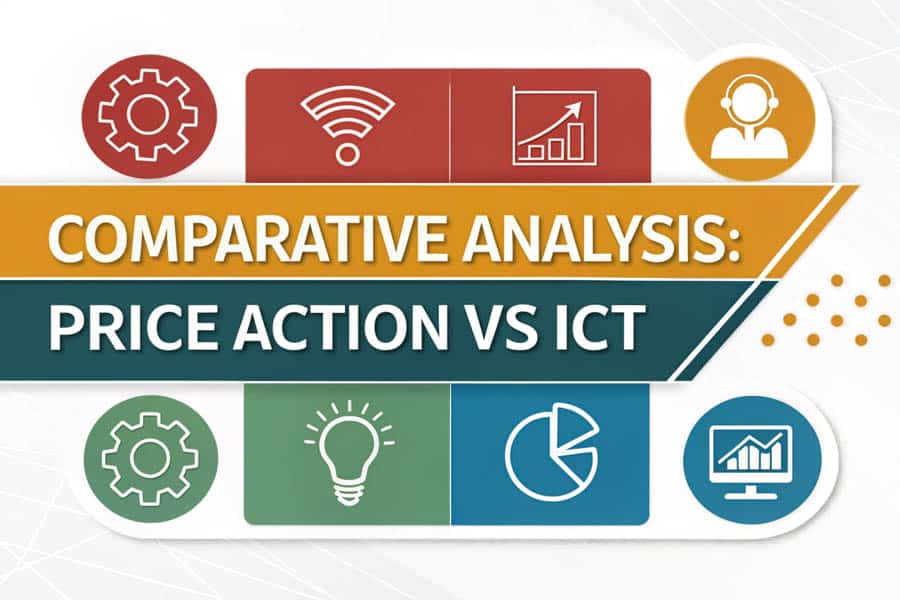
Similarities
Despite their differences, Price Action and ICT trading share several commonalities:
Both strategies emphasize understanding the underlying market trends and patterns, allowing traders to make informed decisions based on the broader market context. Additionally, both methodologies rely heavily on chart analysis and technical indicators to interpret market behavior and predict future price movements.
The shared focus on market structure and technical analysis forms the foundation for both Price Action and ICT trading, providing a structured approach to Forex trading.
Differences
However, there are significant distinctions between the two strategies:
Depth of Analysis: ICT offers a more profound insight into market mechanics, incorporating advanced concepts like liquidity pools and order blocks. In contrast, Price Action remains straightforward, focusing primarily on price movements and candlestick patterns.
Complexity and Learning Curve: Price Action is easier to grasp and implement, making it suitable for beginners. ICT, on the other hand, requires a deeper commitment to learning and understanding complex market dynamics.
Tools and Indicators Used: ICT utilizes advanced concepts and tools such as liquidity pools, order blocks, and market manipulation awareness. Price Action relies on more basic tools like support and resistance levels, trend lines, and candlestick patterns.
Choosing between Price Action and ICT hinges on your willingness to engage with complex concepts versus a preference for a more straightforward, easily implementable strategy.
Read More: Price Action vs SMC
Choosing the Right Strategy for You

Selecting the right trading strategy is a crucial decision that can significantly impact your success in the Forex market. To make an informed choice between Price Action and ICT, consider the following factors:
Factors to Consider
Trading Goals: Define what you aim to achieve. Are you seeking short-term gains through quick trades, or do you prefer long-term stability and consistent growth?
Time Commitment: Assess how much time you can dedicate to analyzing the markets and executing trades. Price Action trading typically requires less time, while ICT trading may demand a more substantial time investment.
Risk Tolerance: Understand your comfort level with potential losses and market volatility. ICT trading, with its advanced risk management techniques, may suit those with higher risk tolerance and a deeper understanding of market mechanics.
Aligning your trading strategy with your personal goals, available time, and risk tolerance is essential for sustained success in the Forex market.
Recommendations
Based on the factors above, here are some tailored recommendations:
- For Beginners: Price Action trading is often recommended due to its simplicity and ease of understanding. It provides a solid foundation for learning the basics of market movements without the overwhelm of complex concepts. Starting with Price Action allows beginners to build confidence and develop essential trading skills before potentially exploring more advanced strategies like ICT.
- For Experienced Traders: ICT trading can offer a strategic edge by delving into the intricate mechanics of the markets. Its advanced techniques, such as liquidity pool analysis and order block identification, can complement existing trading strategies and enhance overall performance. Experienced traders who are willing to invest time in mastering ICT concepts can benefit from its depth and comprehensive market insights.
Choosing the right strategy based on your experience level and trading objectives ensures that your approach aligns with your strengths and goals, paving the way for long-term success.
Pro Tips for Advanced Traders
For those who have mastered the basics and are looking to take their trading to the next level, here are some advanced tips to enhance your Price Action vs ICT trading strategies:
- Integrate Multiple Strategies: Combine Price Action with ICT concepts to create a hybrid approach that leverages the strengths of both methodologies. This integration can provide a more comprehensive view of the market, allowing for better decision-making.
- Continuous Learning: Stay updated with the latest market trends and continuously refine your strategies to adapt to changing conditions. The Forex market is dynamic, and ongoing education is key to maintaining an edge.
- Use Advanced Tools: Incorporate sophisticated charting tools and indicators to enhance your market analysis and decision-making process. Tools like the MetaTrader 5 (MT5) platform offer advanced features that can complement your trading strategies.
- Network with Experts: Engage with experienced traders and join trading communities to gain insights and share knowledge. Networking can provide valuable perspectives and strategies that you may not have considered.
- Backtest Your Strategies: Rigorously test your trading strategies on historical data to identify strengths and weaknesses before applying them in live markets. Backtesting helps in refining your approach and improving its effectiveness.
Implementing these advanced techniques can significantly enhance your trading performance, providing you with the tools and knowledge needed to navigate complex market conditions effectively.
Opofinance Services
When it comes to executing your Price Action vs ICT trading strategies, partnering with a reliable broker is essential. Opofinance stands out as an exceptional choice for traders seeking a secure and efficient trading environment.
Why Choose Opofinance?
Opofinance offers a range of services designed to enhance your trading experience:
- ASIC Regulated: Ensures your investments are protected under stringent regulatory standards, providing peace of mind and security for your funds.
- Social Trading Service: Connect with a community of traders, share insights, and replicate successful trading strategies. Social trading allows you to learn from experienced traders and leverage their expertise.
- Featured on MT5 Brokers List: Recognized for its robust trading platform, Opofinance is officially listed among the top MT5 brokers, offering advanced features and reliable performance.
- Safe and Convenient Deposit & Withdrawal Methods:
- Multiple payment options for easy transactions, including bank transfers, credit cards, and e-wallets.
- Fast processing times to access your funds whenever needed, ensuring seamless trading operations.
Experience seamless trading with Opofinance and take your Forex trading to the next level.

Join Opofinance today and start trading with confidence!
Partnering with a reliable broker like Opofinance ensures that your trading strategies are executed in a secure and efficient manner, maximizing your potential for success.
Conclusion
In the debate of Price Action vs ICT, both trading strategies offer unique advantages tailored to different types of traders. Price Action provides a straightforward, easily understandable approach ideal for beginners and those seeking simplicity. On the other hand, ICT offers a more complex, in-depth analysis suitable for experienced traders looking to gain a strategic edge.
Choosing the right strategy hinges on your trading goals, experience level, and the amount of time you’re willing to invest in mastering the methodology. By understanding the core principles, advantages, and limitations of each approach, you can make an informed decision that aligns with your personal trading objectives and enhances your chances of success in the competitive Forex market.
Remember, the most effective trading strategy is one that not only suits your current skills and knowledge but also aligns with your long-term trading aspirations. Whether you opt for the simplicity of Price Action or the depth of ICT, ensuring that your strategy complements your trading style and goals is key to achieving sustained success.
Key Takeaways
- Price Action is ideal for simplicity and ease of use, making it suitable for beginners. Its focus on price movements and candlestick patterns provides a clear and straightforward trading approach.
- ICT offers advanced insights into market mechanics, catering to experienced traders. Its emphasis on liquidity pools, order blocks, and institutional trading tactics provides a strategic edge in the Forex market.
- Both strategies emphasize market structure and technical analysis but differ in complexity and depth. Understanding these differences is crucial for selecting the right approach for your trading needs.
- Choosing the right strategy depends on your trading goals, time commitment, and risk tolerance. Aligning your strategy with your personal preferences and objectives ensures that your trading approach supports your long-term success.
- Partnering with a reliable broker like Opofinance can enhance your trading experience with secure, regulated services and advanced trading tools. A trustworthy broker provides the necessary support and infrastructure to execute your trading strategies effectively.
By aligning your trading strategy with your personal preferences and objectives, you can navigate the Forex market more effectively and achieve sustained trading success.
How do Price Action and ICT strategies perform in volatile markets?
Price Action trading tends to be more adaptable in volatile conditions due to its reliance on real-time price movements, allowing traders to make quick decisions. ICT strategies, with their deeper market analysis, can also perform well by anticipating large market moves driven by institutional activity, but they may require more time to interpret complex signals.
Can I switch between Price Action and ICT strategies seamlessly?
Yes, many traders find value in integrating both strategies to leverage the strengths of each. By understanding the fundamentals of Price Action and the advanced concepts of ICT, you can create a flexible trading approach that adapts to various market conditions.
What resources are available to learn ICT trading methods effectively?
To master ICT trading methods, consider accessing specialized courses, joining trading communities, and studying materials provided by Michael J. Huddleston. Additionally, practicing with demo accounts and utilizing advanced trading tools can enhance your understanding and application of ICT concepts.



